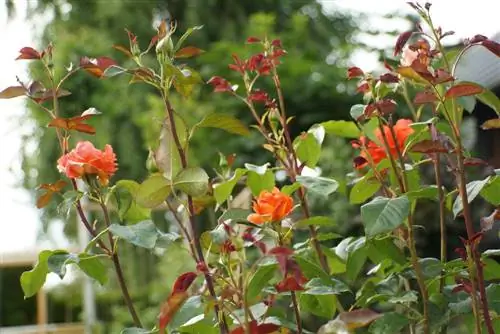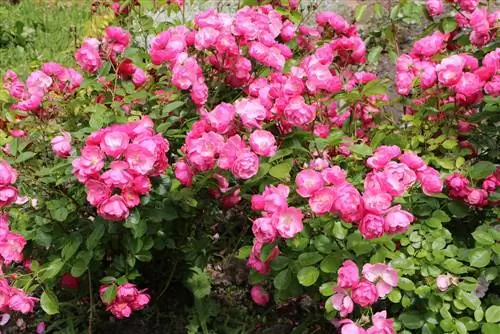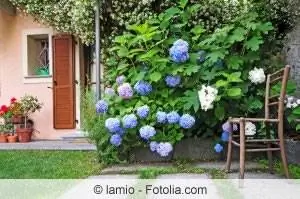- Author admin [email protected].
- Public 2023-12-17 03:39.
- Last modified 2025-01-24 12:45.
If the roses lose their ability to bloom, you have to think about the reasons. The location should also play a role here. So the soil may have become tired and no longer release enough nutrients to the roots of the roses. But a dark location can also prevent roses from blooming. In such cases, it makes sense to replant old roses as well as young ones so that they bloom splendidly again.
Up to what age?
If the old rose no longer blooms, then the main question is up to what age can rose bushes or bushes be transplanted?Young plants do not yet have long and thick roots and can therefore be planted in a new location. But here too, attention must be paid to the young roots. But older roses can also be transplanted if done carefully. These can only be damaged by accidentally cutting roots.
Appropriate timing
It is important to find the right time to transplant roses that have already been cultivated. So the best time is in winter. Between November and the end of February, before the rose sprouts again, it should be transplanted if this is absolutely necessary. The reasons for this are as follows:
- When standing in full foliage, the shoots dry out more quickly
- Unleaved roses do not lose water
- can you put your strength into growth
- even transplanting in frost is possible
- Protect the rose bush immediately after planting
- Mulch, leaves and brushwood
Tip:
However, the ideal day for transplanting in winter is frost-free. Because when the ground is frozen, it is difficult to dig up the earth. It therefore makes more sense to carry out the work on a frost-free day after a rain, as the soil can then be worked best.
Right tool
The right tools should be prepared before transplanting. Then the work will be done more quickly later. These mainly include:
- Spade
- Gardening Gloves
- Roses scissors
- possibly wheelbarrow to mix the new soil
- Watering can or hose
- Bucket with water
Due to the thorns that could injure the skin while working, it is also a good idea to wear long trousers and long-sleeved tops.
Taking young roses
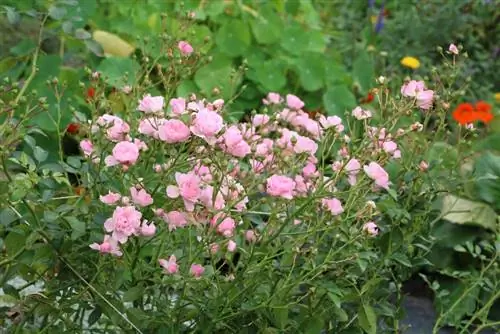
Removing young roses is a little easier because the roots are not yet very developed. However, you should work with caution; the distance around the roses should be as large as possible when the spade is applied. The young roses are dug up from below and the roots are freed from the old soil. The procedure continues as follows:
- Carefully dig up roses with a spade
- cut off damaged roots
- also remove dead roots
- Shorten all root ends slightly
- this stimulates the formation of new roots
- cut back the upper shoots to 20 cm
- At least five buds should remain per shoot
Removing old roses
In older to old roses, the root system is very pronounced. However, this should under no circumstances be damaged when transplanting. Therefore, it is important to measure generously around the plant when digging up the rose bushes. Therefore, the procedure is as follows:
- prick around the bush with a spade
- leave enough space in the middle
- so some of the fine roots remain protected
- drive the spade deep into the ground
- lift carefully from below
- Removing roses from the hole without soil
- cut off broken roots
- Cut above-ground parts to within a hand's width of the finishing point
- not in perennial wood
Tip:
If old roses are transplanted, this work should be done at the beginning of November and not just before the next spring. Then the bushes have more time to take root before they sprout again.
Preparation of the new location
Before the roses are planted in a new location, it must be prepared. It is important to create drainage to avoid waterlogging. To do this, the planting hole, which should have a diameter of at least 40 cm, is dug and stones, shards of pottery or gravel are placed on the bottom of the hole. When it comes to depth, it is also important that the roots, especially of older roses, are not snapped and that they have enough space. The soil at the new location should be prepared so that the roses bloom quickly and profusely again. The soil is prepared as follows:
- prepare several weeks in advance
- then the nutrients can be distributed better
- Fix compost
- Sand and clay for permeability
- horn shavings are also recommended
Tip:
When choosing a new location, you must always consider that there have been no roses here for a long time, otherwise the soil can become tired and the roses will not bloom in the new location.
Planting in a new location
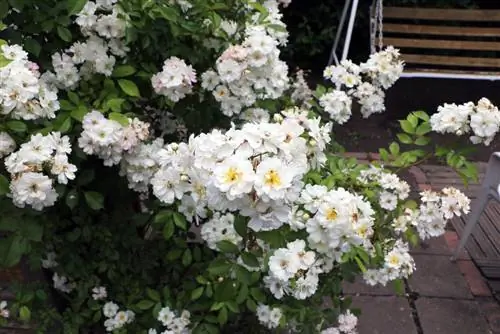
If the roses were removed from the old location, they should be planted in the new location immediately. The roots should be freed from the old soil as much as possible. The bare-root plants are then placed in a bucket of water for a few hours so that they can soak up. Then proceed as follows:
- Carefully place roses in the planting hole
- add prepared soil
- Refining site must be five centimeters underground
- this protects it from stress cracks caused by winter sun
- After filling, compact well with foot
- otherwise cavities could arise
- then water well
- this ensures good soil contact with the roots
Tip:
If a watering edge is formed around the plant, the water goes directly into the planting site and does not flow off to the side.
Hill up after planting
The most important thing for roses is to pile them up after planting. It is irrelevant whether the roses were transplanted in late autumn or late winter. The piling up serves to protect against frost, which can still be expected in late winter. The procedure is as follows:
- pile up the soil around the rose
- for this, the soil is placed 15 cm high around the rose bush
- If planted in autumn, leave until spring
- remove afterwards when frost is no longer expected
- When planting in spring, also leave until the last frost
- If the rose has clearly sprouted again, remove the accumulation

